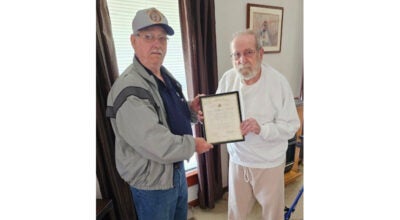Virginians to decide on state amendments
Published 9:15 pm Wednesday, October 21, 2020
|
Getting your Trinity Audio player ready...
|
There’s more than just a presidential election happening on Nov. 3. There’s two proposed amendments for Virginians to consider. Below are what will appear on the ballots that day, followed by an explanation of each.
Constitutional Amendment No. 1
Should the Constitution of Virginia be amended to establish a redistricting commission, consisting of eight members of the General Assembly and eight citizens of the Commonwealth, that is responsible for drawing the congressional and state legislative districts that will be subsequently voted on, but not changed by, the General Assembly and enacted without the Governor’s involvement and to give the responsibility of drawing districts to the Supreme Court of Virginia if the redistricting commission fails to draw districts or the General Assembly fails to enact districts by certain deadlines?
Acceptable answers:
• Yes
• No
Explanation: Earlier this year, Virginia’s lawmakers approved a state constitutional amendment, which if approved by voters this November, would, for the most part, remove the process of redrawing the state’s General Assembly and congressional voting districts from partisan control.
The amendment calls for the creation of a 16-member Virginia Redistricting Commission, comprised of eight Democrats and eight Republicans — four from the House of Delegates, four from the state Senate, and another eight citizens who are not elected to either branch of the state legislature. Virginia’s speaker of the house and Senate president pro tempore would be tasked with nominating at least 16 names to serve on the committee, but the actual appointment of these individuals would be made by a committee of retired Circuit Court judges.
For new district maps to be approved, a super-majority of at least three-fourths of the commission (six out of eight legislators and six out of eight citizens) would be needed. The General Assembly would then vote yes or no on the new maps, but would not be allowed to make changes to the commission’s recommendations.
The plan, which received near-unanimous backing from Virginia’s Senate in March, is supported by the anti-gerrymandering group One Virginia 2021. But, there’s a catch. If the commission can’t get a three-fourths majority to agree on a map in the time frame allowed, or if the General Assembly rejects the commission’s map twice, the state Supreme Court is authorized to come up with its own district maps.
Right now, Virginia’s Supreme Court is more conservative-leaning, as the bulk of the justices were appointed by the General Assembly when Republicans had control of the legislature, not counting the fairly liberal Justice S. Bernard Goodwyn, whom Sen. Tim Kaine appointed in 2007 when he was governor of Virginia.
“This has been the sticking point for some legislators arguing against this amendment, including Delegate [Mark] Levine,” said Old Dominion University political science professor Benjamin Melusky. “Given that legislative leaders of both parties have a role in selecting the legislative members of the commission, as well as creating the list of citizens for selection by the five retired circuit court judges (and partisan balancing requirements, which give the opposition party power within the commission), members like Levine have contested that opposition party members of the commission could easily organize to veto any maps drawn by the commission, tossing it to the Republican-selected court.”
In the House, the proposed amendment passed 54-45 over the objection of Black Caucus members, who had criticized the proposal as not going far enough to prevent racial gerrymandering.
If the voter referendum is successful, the commission will be formed in time to redraw Virginia’s legislative districts by 2021. If it is defeated, Democrats, who won control of both state houses in 2019, will retain the final say on voting district boundaries next year.
Constitutional Amendment No. 2
Should an automobile or pickup truck that is owned and used primarily by or for a veteran of the United States armed forces or the Virginia National Guard who has a one hundred percent service-connected, permanent, and total disability be free from state and local taxation?
Acceptable answers:
• Yes
• No
Explanation: The Constitution of Virginia requires that all property be taxed, but contains provisions specifying that certain types of property are exempt from taxation. If the proposed amendment is approved, a service member who has been rated by the U.S. Department of Veterans Affairs to have a 100% service-connected, permanent and total disability would be allowed to exempt a single car or truck from state and local personal property taxes, provided he or she is the primary user of that vehicle.
State Sen. Bryce Reeves (R-Spotsylvania) carried the legislation this year after it was first introduced in 2019 by Delegate Eileen Filler-Corn (D-Fairfax), who now serves as Speaker of the House of Delegates.
According to Reeves, the amendment is intended to benefit veterans such as those who have lost limbs in the service, who need specialty features added to their vehicles to remain able to drive. These features often make such vehicles very expensive.
But the tax exemption would apply to any veteran that meets the above criteria, whether the vehicle has been modified or not, and regardless of how much income that person is earning. Critics of the amendment, such as tax expert Richard C. Auxier, of the Urban-Brookings Tax Policy Center, say this would embed inequities in Virginia’s constitution.
“You could have two neighbors: one neighbor is a veteran who’s currently working a new job that pays $200,000 a year and next door is her neighbor, who’s a teacher, who gets paid $50,000 … the question isn’t do you want to help veterans, it’s do you think the $200,000 veteran deserves the tax break but the $50,000 teacher doesn’t?” he recently told reporters with CBS affiliate WUSA9.
Auxier added that Virginia, and its local governments, which had been receiving this tax revenue, would then need to make up for the resulting shortfall.





